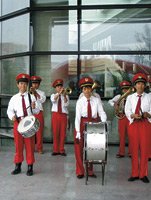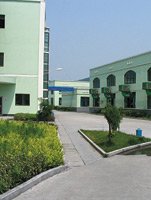Exploring China as a New Apparel Frontier
SHANGHAI, China—If you’re going to do business in China, be prepared to be served duck tongue or still-squirming lobster. And if someone tells you his not-to-be-missed factory is only one hour away, brace yourself for a two-hour trip.
You should also expect massive factories featuring seemingly endless production lines and factory owners prepared to lavishly wine and dine prospective clients in the hopes of landing a big order.
Those were just a few of the lessons learned by some of the 87 apparel industry people who wrapped up a 16-day sourcing tour of China organized by Cyber Merchants Exchange, based in El Monte, Calif.
The May 20–June 5 tour took the disparate group on a road trip to five cities that are major apparel and textile centers in this burgeoning country, which accounted for 22.5 percent of all U.S. apparel imports in the first quarter of 2005.
Traveling in three buses or hopping planes, the group went to Shanghai, Suzhou, Hangzhou, Guangzhou and Shaoxing to visit trade shows, see factories, attend dinners and hobnob with apparel manufacturers eager to do business despite the recent approval of U.S. safeguard measures on seven apparel and textile categories.
This was the first tour organized by Frank Yuan, chief executive and founder of Cyber Merchants, who puts on the ASAP Global Sourcing Show twice a year during MAGIC International in Las Vegas. He also organizes a sourcing show for Material World in Miami, a trade show for textiles, sewing equipment and sourcing.
The China trip brought buyers together from Europe, Central America, South Africa, Asia and the United States who were looking for such goods as men’s shirts, suits, pajamas, T-shirts, uniforms, women’s dresses, skirts and sweaters.
Most of the travelers represented small to mid-size apparel businesses wanting to cut costs. Others were from heavy-hitting companies such as The Warnaco Group Inc., Salvatore Ferragamo, Intersport and Paul Smith Ltd.
Fruit of the Loom sent three sourcing executives, two from Europe and one from the United States. Raquel Baez, a Fruit of the Loom sourcing manager from Bowling Green, Ky., was looking for factories in China to produce underwear to sell to Wal-Mart stores in China. Currently, Fruit of the Loom does 90 percent of its production in El Salvador and Honduras.
Taro Nemoto, a sourcing coordinator in New York for Warnaco, was searching for factories to produce cheaper lingerie. He said the $1.4 billion company’s Hong Kong office normally handled sourcing but the New York office was getting more involved.
Several companies that now do business in Central America were looking elsewhere. “There’s no doubt this is the place you want to be. It’s all here,” said Mark Gitomer, president of The Production Department, a company based in Pennsylvania that manufactures polar-fleece goods for L.L. Bean and other apparel at its factory in El Salvador. “Costs are half of what I’m used to paying.”
My dinner with Yang and Li
The concentrated search for factories not only afforded a glimpse into China’s manufacturing world but also opened a window into Chinese culture.
Factory owners often picked up potential customers in late-model cars with leather seats and ushered them off to factories that were anywhere from 20 minutes to more than two hours away.
After a complete tour of the showroom and the facilities, the next inevitable step in the courting process was for the factory owner or general manager to invite potential clients out for an elaborate lunch or dinner held at a top-end restaurant.
That was the case for Daniel Sadigh, chief operating officer at Los Angeles–based Sugar-Moods Ltd., a company that makes contemporary and moderate womenswear. After hosting a showroom tour of Wuxi Baili Clothing Co., which produces 80 percent of its knit sweaters for Bebe, Tiger Li, one of the company’s owners, invited Sadigh to dinner at a lakeside restaurant.
Inside a private dining room set with a yellow linen table cloth, gilded plates and three sets of wine glasses, a long and varied conversation took place, ranging from housing to health care.
Sadigh learned that in China, as in Los Angeles, real estate prices and health-care costs are rising and pensions are stretched. In Wuxi, a city of about 2 million, a 900-square-foot house with three bedrooms now costs about $70,000, a steep rise from the price tag available a few years ago. In addition, the Communist government is starting to charge for medical visits at the hospitals. And Li’s father, a farmer, and his mother, a housewife, had retired but were supported by their two sons because their government pension did not cover their expenses.
After a dinner of garlicky cucumbers, green peppers, seafood, spicy pork, soup, dumplings and dessert, Li apologized for the meagerness of the meal. Then he spent 2 1/2 hours driving Sadigh back to his out-of-the-way hotel in Suzhou, presenting him with a gift wrapped in pink paper. Inside was a glass-encased floral painting.
Romancing the client
Chip Smoler got the VIP treatment after placing an order for 60,000 pairs of pajamas with Rick Yang, general manager of Suzhou Industrial Park Sunrise Garment Co. Ltd. Smoler, president of Admar Trading Corp. in Chicago, bought the pajamas for Meijer, a discount food and general merchandise chain in the Midwest that was planning to put the goods on its shelves in time for Fall and Holiday shopping.
After dropping off Smoler in Suzhou to do a little sightseeing, Yang later had a driver take his new client to the wholesale pearl market to shop for jewelry. That night, in his brand-new Volvo, complete with a built-in cell phone in the dashboard, Yang picked up Smoler for dinner inside a restaurant with a forest of fake trees.
Over a meal of spicy chicken, shredded eggplant and fresh fish (brought to the diners still alive in a plastic bag to assure its freshness before cooking), the conversation focused on family. Yang revealed he has two children, one more than the government allows. For that extra child, Yang had to pay a 40,000 yuan fine, the equivalent of $4,800. The average apparel worker in China makes only $100 to $120 a month for a six-day work week.
After a few beers and more pleasantries, Yang made a hasty request. Could he subcontract some of the pajamas production to a couple of nearby factories? Obviously irked, Smoler sighed and said, “I knew this was coming.” After touring the factory of 180 workers, the Chicago resident said he had wondered how Yang’s company could get his order completed on time.
Sensing Smoler’s displeasure, Yang backed off from the unwelcomed proposal. But the next day at a morning meeting, Smoler agreed to the subcontracting idea as long as Yang inspected all the work and guaranteed its quality.
Alan Tiegen, chief executive of White Lava Trading in Laguna Beach, Calif., which imports T-shirts for screen printers and surf- and skateboard-oriented retailers, was taken out to dinner in Ningbo, an apparel manufacturing center on the East China Sea coast.
He vividly remembered that one afternoon his lunch came with a bit of unexpected entertainment. The freshly cooked lobster was so fresh its tail started moving. The crustacean wiggled off the plate and onto a diner’s lap. After the woman screamed, the lobster was returned to its plate, and everyone continued eating.
Despite the culinary escapade, Tiegen was sold on China. “Ningbo is a great place to do business, and the Chinese are nice,” he said. “I’ll definitely be back.”
Right now, Tiegen has to figure out how to deal with the safeguard measures so he can switch his cotton T-shirt production from Bangladesh, where he said he feels unsafe when he visits.
Two extremes
Most everyone on the trip was impressed with the giant-sized factories that were fairly well organized, clean and housed on sprawling campuses in industrial parks.
But some expressed concerns about certain less-than- ideal conditions they found. Will Vereen, corporate vice president of Riverside Manufacturing Co. in Moultrie, Ga., veered from the group for a few days and visited apparel plants near Beijing. In one factory filled with 5,000 workers, he saw a tough security guard patrolling with a German shepherd dog. He also saw five security guards carrying truncheons. “Does that sound normal?” he asked.
In a second factory, Vereen said he noticed a worker who appeared to be about 11 years old. When he inquired about the young man’s age, the factory owner replied that the worker was too shy to tell Vereen his age.
“I can’t be using factories that abuse workers,” said Vereen, whose nearly 100-year-old company makes uniforms for companies such as United Parcel Service Inc., The Coca-Cola Co. and Anheuser-Busch Cos. Inc. He is considering China as a good replacement for his production in East Europe, which supplies uniforms and other goods to the European Union market.
Cheap, cheap
Cost savings was the No. 1 factor pushing everyone to take an intense look at China as a place to do business. Efficiency was the No. 2 reason.
Very few people placed orders while on the trip, but they did collect samples and hash out when to place orders now that safeguard measures have limited the importing of several Chinese clothing categories. All were convinced that China was the place to be.
“I’ve resisted this for a while,” said Joe Greco, president of Greco Apparel, a Pennsylvania-based company that has been making uniforms and tuxedos with contractors in the Dominican Republic for 20 years.
While in China, Greco shopped for fabric, checked out factories to produce clothing and thought about developing some non-apparel business. Quota restrictions played a big role in his decisions. “I can’t afford to have merchandise sitting in limbo,” he said. “People depend on me to keep their warehouses stocked.”
For Brian Scully, China might seem like an unusual place to do business. His family-owned Scully Inc., an Oxnard, Calif., company founded in 1906, makes Westernwear. The company started sourcing in China five years ago and now produces 50 percent of its apparel in China. This was his first visit to the country, where he found prices were 20 percent to 40 percent cheaper than in the United States.
“Competition is what prompted us to come here. Retailers want lower prices. Either you go to China, or take it out of your profit margins,” he said. “But I guess doing Westernwear in China sounds kind of odd. Maybe we should call it Easternwear.”
























